Newcastle, KwaZulu-Natal
hideThis article has multiple issues. Please help or discuss these issues on the talk page. (Learn how and when to remove these template messages)
|
Newcastle | |
|---|---|
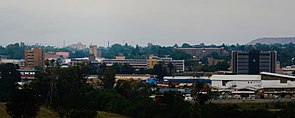  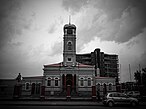   From the top: Downtown Newcastle Town Skyline from Fort Amiel Museum, Sculpture by Mohau Modisakeng at Entrance 03 of the Newcastle Mall, Newcastle Town Hall, Newcastle from Hilldrop and Arcelor Mittal Newcastle Works | |
 Newcastle | |
| Coordinates: 27°44′47″S 29°55′58″E / 27.74639°S 29.93278°ECoordinates: 27°44′47″S 29°55′58″E / 27.74639°S 29.93278°E | |
| Country | South Africa |
| Province | KwaZulu-Natal |
| District | Amajuba |
| Municipality | Newcastle |
| Established | 1864[1] |
| Government | |
| • Mayor | Dr Ntuthuko Mahlaba (African National Congress[2]) |
| Area | |
| • Total | 75.79 km2 (29.26 sq mi) |
| Elevation | 1,194 m (3,917 ft) |
| Population (2011)[3] | |
| • Total | 363,236 |
| • Density | 4,800/km2 (12,000/sq mi) |
| Racial makeup (2011) | |
| • Black African | 51.9% |
| • Coloured | 3.8% |
| • /Asian | 19.8% |
| • White | 23.6% |
| • Other | 0.9% |
| First languages (2011) | |
| • Zulu | 37.4% |
| • English | 35.4% |
| • Afrikaans | 20.7% |
| • Sotho | 1.0% |
| • Other | 5.5% |
| Time zone | UTC+2 (SAST) |
| Postal code (street) | 2940 |
| PO box | 2940 |
| Area code | 034 |
| Website | www |
Newcastle is the third-largest city in the province of KwaZulu-Natal, South Africa, with a population of 414,996 citizens according to the latest NLM Final IDP Review. The bulk of these citizens reside in Newcastle East, in the main townships of Madadeni and Osizweni, with the balance residing in Newcastle West.
Set at the foothills of the northern KwaZulu-Natal Drakensberg Mountains, Newcastle is located in the northwest corner of the province along the and is one of the country's main industrial centres.
Newcastle's municipal area is 188 square kilometres (73 square miles), consists of 31 wards and a population growth rate of 1.34% per annum, ranking Newcastle as South Africa's tenth-largest city.
The N11 and R34 are the principal roads linking the city to the rest of South Africa.
Newcastle is the seat of the local municipality as well as being the seat to the Amajuba District Municipality.
History[]
Name controversy[]
Newcastle has changed names on numerous occasions during the country's historic rule. It was initially named Post Halt Number 2 on military maps during the 1840s, as postal coaches stopped here to obtain fresh horses on the journey between Durban (then Port Natal in Zuid-Afrikaansche Republiek)[4] and Johannesburg. It was later known as the Waterfall River Township because of the . Newcastle received her name after the British Colonial Secretary, the fifth Duke of Newcastle, a British aristocrat, and not the city in England as some believe. During the Anglo-Boer War, Newcastle was invaded by Boer forces on 14 October 1899, and the entire district was incorporated into the Transvaal Republic. Newcastle's name lasted for a period of seven months when it was renamed to Viljoensdorp after the commander of the Johannesburg Commando, General Ben Viljoen. However, after relief of Ladysmith under the command of General Redver Buller, the British forces reclaimed the name back to Newcastle.
Establishment[]
Newcastle (then Post Halt Number 2) was strategically placed in 1854 by the Surveyor General of the Natal Colony, Dr PC Sutherland on the banks of the flooded . In 1864, Newcastle was founded on the site, becoming the fourth settlement to be established in Natal after Durban, Weenen and Pietermaritzburg.
War and British rule[]
In 1876, Fort Amiel was constructed to ward off the Zulus during the war. In 1873 Newcastle became a separate electoral division.[5] To commemorate Queen Victoria's Diamond (60th) Jubilee the construction of a sandstone town hall started in 1897, and was completed two years later. The town was used as a depot by the British during both the First and Second Boer War. Newcastle functioned as a major transport junction and stopover for wagons and post chaises during the late 19th century.
British preparation work for the Pretoria Convention of 1881 was done at Newcastle.[6]
The Industrial Era[]
In 1890, the first train arrived in Newcastle, and the town was declared a borough in 1891. The discovery of coal brought a new era of prosperity and several ambitious building projects were planned. In 1920, the Union Steel Corporation built the provinces first steel plant, which later became the ISCOR South Works and subsequently decommissioned the plant after the ISCOR North Works was built, now Arcelor Mittal Newcastle Works today.
Newcastle today[]
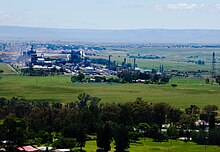
Today, Newcastle is the main commercial and industrial centre in northern KwaZulu-Natal, and is the provinces third largest city. Continuous development has seen this city being a leader in its class and the municipality is striving to make the city sustainable by 2030. The city is the gateway to the Zulu Kingdom from the Free State and Mpumalanga.
Geography and climate[]
Located at approximately 1,194 metres (3,917 feet) above sea level, Newcastle is found in the North West corner of the province of KwaZulu-Natal at the foothills of the northern Drakensberg mountains. The city has a temperate climate and is classified under the country's 'Cold Interior'. Temperatures in Newcastle often drop below freezing during the winter months, with snowfall often experienced at least twice a decade. Newcastle's summer temperatures have in the recent past exceeded 40 degrees Celsius, due to the 2015 El Niño weather phenomenon, with the region experiencing drought conditions after 28 years.
| hideClimate data for Newcastle | |||||||||||||
|---|---|---|---|---|---|---|---|---|---|---|---|---|---|
| Month | Jan | Feb | Mar | Apr | May | Jun | Jul | Aug | Sep | Oct | Nov | Dec | Year |
| Record high °C (°F) | 38 (100) |
36 (97) |
37 (99) |
32 (90) |
30 (86) |
27 (81) |
25 (77) |
28 (82) |
39 (102) |
40 (104) |
43 (109) |
38 (100) |
43 (109) |
| Average high °C (°F) | 28 (82) |
28 (82) |
27 (81) |
25 (77) |
23 (73) |
20 (68) |
20 (68) |
23 (73) |
26 (79) |
27 (81) |
28 (82) |
29 (84) |
25 (77) |
| Average low °C (°F) | 15 (59) |
15 (59) |
16 (61) |
9 (48) |
4 (39) |
2 (36) |
2 (36) |
5 (41) |
8 (46) |
12 (54) |
13 (55) |
14 (57) |
10 (50) |
| Record low °C (°F) | 9 (48) |
10 (50) |
5 (41) |
2 (36) |
−1 (30) |
−6 (21) |
−5 (23) |
−3 (27) |
−1 (30) |
3 (37) |
5 (41) |
6 (43) |
−6 (21) |
| Average precipitation mm (inches) | 137 (5.4) |
111 (4.4) |
83 (3.3) |
41 (1.6) |
13 (0.5) |
10 (0.4) |
10 (0.4) |
24 (0.9) |
38 (1.5) |
91 (3.6) |
105 (4.1) |
121 (4.8) |
784 (30.9) |
| Average precipitation days | 19 | 12 | 10 | 6 | 2 | 2 | 5 | 10 | 6 | 9 | 16 | 18 | 115 |
| Source: South African Weather Service[7] | |||||||||||||
Demographics[]
Zulus form the largest single ethnic group. Due to its past, Newcastle has a large number of people of British descent, Afrikaners and Indians, with several places of worship and spiritual organizations around the city's suburbs.
The city has since the mid 1980s seen an influx of Chinese nationals. While making up a small percentage of Newcastle's population, they have contributed extensively to the economy. With approximately 200 Chinese-owned businesses, they have left their mark on Newcastle making it a leader in the textile and plastic manufacturing industry. The abolishing of Apartheid has seen the establishment of the Buddhist Light Association's Mediation Centre and Chinese School on Victoria Road.
Indian nationals, Pakistan nationals as well as African foreign nationals have since 1995 flocked to the city in search of a better life, now calling Newcastle their home.
Economy[]
From the 1880s, Newcastle experienced constant economic growth. Today, Newcastle has the largest concentration of commerce & industry in northern KwaZulu-Natal.
This city serves the surrounding towns of Utrecht, Vryheid, Dannhauser, Glencoe and Dundee, maize, livestock and dairy farmers and country at large with an extensive amount of resources, products and goods some of which are also for export.




Industry[]
The city has 4 industrial areas, namely Riverside Industrial, Airport Industrial, Madadeni Industrial Estate & Arcelor Mittal Newcastle Works.
The Newcastle economy is strong, being dominated by heavy industry, clothing & textile, services and engineering industry. There is also considerable coal mining in the area.
Although the Arcelor Mittal steelworks, the Natal Portland Cement (NPC) slagment cement plant, the LANXESS Chrome Chemical Plant and the synthetic rubber plant (which covers 500,000 square metres (5,381,955 square feet) of manufacturing space) dominate the Newcastle industrial portfolio, there is a wide range of manufacturing undertakings sharing in the success of the region. Heavy Engineering Works such as DCD Venco and Boschpick Engineering supply ancillary services to these large concerns and undertake work throughout the region and country as a whole. Newcastle has welcomed many Chinese and Taiwanese into the region with the addition of over a hundred textile factories located in Riverside Industrial and Madadeni Industrial Estate.
In 2011 Independent Power South Africa (IPSA) converted the old Ngagane Power Station into the Newcastle Cogeneration Plant, an 18 MW gas fired powerstation that provides a dedicated power supply to the Plant.
An indication of the industrial future of Newcastle is reflected in the chrome chemical plant, which was completed in Newcastle during 2002. This joint venture project between Karbochem and German speciality chemical manufacturing giant LANXESS has made Newcastle the largest producer of chrome chemicals in Africa. The company announced an investment of €40 million in 2012 towards the construction of an innovative CO2 plant (Cansolv chemical process) at its site.
Arcelor Mittal Newcastle produces over 1.5 million tons of long steel products annually, and as part of its commitment to Newcastle undertook a major reline on the N5 Blast Furnace in 2015 to the tune of R1.8 billion.
In mid 2014, a portion of Airport Industrial was renamed to Newcastle Chemical Park, this being the home of African Amines (Pty) Ltd, Karbochem (Pty) Ltd, KC Energy (Pty) Ltd, LANXESS (CISA) (Pty) Ltd, Newcastle Co-generation (IPSA) and South African Calcium Carbide (Pty) Ltd.
Other large operations include firms such as Formosa Plastics and Nova Clothing, both of which manufacture goods for the country's leading retailers, a diamond cutting works, various engineering concerns, building industry related services such a brick manufacturing, roofing systems and steel reinforcement.
Retail[]

Newcastle has a very strong local trade, which is boosted from the surrounding towns of Utrecht, Vryheid, Dannhauser, Glencoe, Dundee and Ladysmith.
Despite the development of decentralized shopping malls and centres around Newcastle, it's CBD still continues to trade strongly. The city has various major shopping facilities spread throughout, the most notable being the award-winning Newcastle Mall adjacent to the Blackrock Casino, Amajuba Mall, Newcastle Corner, Victorian Mall, Village Walk, Scott Street Mall, The Factory Plaza, Taxi City, Ithala Shopping Centre,Madadeni Crescent,Eyethu Junction Shopping Centre in Madadeni and Theku Plaza in Osizweni.
Buildings and roads[]



Recent development in Newcastle include the new multi-storey Civic Centre; Victorian Mall expansion; the Meadowlands Estate in Madadeni; the Vulintaba Country Estate in the Drakensberg outside Newcastle, Newcastle Corner, and on Newcastle's mixed-use precinct - the Equarand.
Constant roadworks are undertaken to ensure free traffic flow around the city. Recently the D96 was rebuilt, the Allen Street Bridge and widening of Allen Street along Trim Park was completed, Link Road extension Phase 1 completed, and Albert Wessels Drive extension Phase 1 completed. Phase 2 of the latter are currently in planning stages.
Proposed future projects include the Newcastle Technology Hub, expansion of the Newcastle Airport, and the re-alignment of the N11 bypass south of Newcastle by SANRAL.
Tallest structures[]
Industrial[]

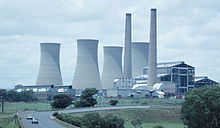


- Arcelor Mittal
Arcelor Mittal has a number of tall structures exceeding 50 metres (160 feet) in height. The most notable on Newcastle's skyline are: The 2 Stacks are 140 metres (460 feet) tall. The N5 Blast Furnace is 110 metres (360 feet) tall. The Coke Ovens are 70 metres (230 feet) tall.
- Newcastle Co-generation Plant
The 2 stacks are 120 metres (390 feet) tall. The 4 cooling towers are 94 metres (308 feet) tall.
- Natal Portland Cement
The lift structure for the main 4 silos is 78 metres (256 feet) tall.
- Newcastle Chemical Park
This facility has several tall industrial structures and stacks above 50 metres (160 feet) in height.
Telecommunications[]
The Signal Hill Tower is 72 metres (236 feet) tall.
Buildings[]
- Arcelor Mittal Head Office Building: 10 storeys - Structural Height is 50 metres (160 feet) & Top of Antennae is 70 metres (230 feet).
- DBM Building: 9 storeys - Structural Height is 44 metres (144 feet) & Top of Antenna is 54 metres (177 feet).
- Newcastle Civic Centre: 9 storeys - Structural Height is 40 metres (130 feet).
Tourism[]


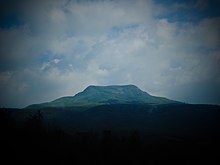
As Newcastle is on the alternate route to travellers from Gauteng to Durban, attempts have been made to capture some of the potential tourist spend by enticing travellers to visit the scenic and historic Battlefields Route where war once raged Battlefields Route Website. Apart from a few hotels, there are many Guest Houses and Bed & Breakfast providing luxurious accommodation. Historic Places of Interest in Newcastle on this route include:
- Newcastle City Hall
- The Carnegie Art Gallery
- Haggards Hilldrop House
- The Armoury
- Newcastle Cemetery
- Hindu Shiva Temple
- Chief Albert Luthuli and the Blaauwbosch Methodist School and Church
- King Dinuzulu & the Old Prison
- Maharaj House
- Fort Amiel Museum
- O'Neills Cottage
- Majuba Mountain
Transport[]
Road[]
Newcastle is well connected to Gauteng & the provinces coastal ports of Durban and Richards Bay on two main routes. The N11 is the principal road running through the city connecting it south to the N3 to Durban and north to the N4 to Gauteng, and through the provinces of Mpumalanga & Limpopo, and eventually to the border at Groblersbrug.
The R34 connects Newcastle to Gauteng via the N3 and the Free State to the West, and Easterly to the port of Richards Bay via Vryheid and Empangeni.
Rail[]
Newcastle lies on the main passenger and goods railway line between Johannesburg and Durban. The city has a large rail siding and cargo facility.
Airport[]
Newcastle has one Airport which is located approximately 7 kilometres (4.3 miles) away from the city centre. Chartered flights commute daily and a full service with one of the country's airlines is in the pipeline.
Taxis and buses[]
Mini bus taxis are the most affordable and quickest form of transport for the majority of the population for those residing in Newcastle East. These are owned by Taxi Associations, and in the recent years inter-operator violence has flared up from time to time, especially as turf wars over lucrative taxi routes resulting in the deaths of many Taxi Bosses.
Apart from the thousands of taxis that traverse the city streets daily, Transnat Coach Lines & Stabus (subsidiaries of Tans Africa Holdings (Pty) Ltd) are the largest bus operators in Newcastle.
Society and culture[]
Galleries[]
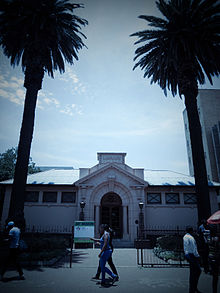
- The , represents South African artists as well as local artists. This historic building falls within city's Civic Precinct.
Museums, monuments and memorials[]
- Fort Amiel Museum, which is a typical Victorian frontier fort is a National Heritage Site.[8]
Music[]
Newcastle is home to the Northern KwaZulu-Natal Youth Choir[9] – a provincial choir of international repute.
The annual Vodacom Winter Festival[10] aka 'Newcastle Show', provides a platform for South African bands and singers and attracts visitors from the entire region. Notable performers who have performed for the event in 2018 include Matthew Mole, Cassper Nyovest, Majozi, Snotkop, and Jo Black.[11]
Places of worship[]
Newcastle has all of the countries religious organizations represented. Churches, Temples and Mosques can be found all around the city. Landmarks include the NG Kerk on York Street, and the Hindu Shiva Temple on Kirkland Street. Built in 1903, the temple is reputed to have the largest cella dome of its kind in the Southern Hemisphere. It is claimed that in 1913, Mahatma Gandhi prayed here while leading the march from Newcastle to the Transvaal.
The Darul Uloom on St Thomas Street, an institute of Higher Islamic studies is yet another landmark in Newcastle's diverse community with a modern Mosque on the premises.
Sport[]
Newcastle remains a venue for major sports competitions and conferences because of the facilities the city has to offer. A variety of rugby, cricket, soccer, squash, tennis, swimming and other sport facilities has contributed to its ability to host both national and international events.
Stadia[]
Newcastle has numerous multi-purpose stadia around the city, which are mostly used to host local sport competitions, school sports and inter-school sports. These accommodate, Soccer, Cricket and Rugby, Squash Courts, Tennis Courts and Volleyball Courts.
The most notable of these are the Newcastle Swimming Pool, Arbor Park Grounds, Paradise A & B, and the Madadeni Sports Stadium.
Swimming[]
The Olympic-sized Newcastle Swimming Pool in Sunnyridge (previously Ferrum Swimming Pool) has in the recent past hosted the All-Africa Development Gala.
Newcastle has 5 public swimming pools.
Sports complex[]
Located in Arbor Park, this modern complex has indoor and outdoor facilities, with a bowling green.
Wrestling[]
Newcastle Wrestling Academy is one of the top wrestling clubs in the province of Kwa-Zulu Natal.
Fishing[]
Newcastle is home to the Challengers Angling Club. An annual angling competition is held to assist local charities.
Rugby[]
The local rugby club is the Newcastle Highlanders Rugby.
Soccer[]
On the soccer front, Newcastle is home to Stella Football club which over the years has produced players to represent the province and country.
Cricket[]
Newcastle has a local cricket league, and matches are hosted at various stadiums around the city.
Golf[]
Newcastle has 2 Golf Courses, Newcastle Golf Club with mashie course, and Vulintaba Country Estate.
Horse riding[]
Newcastle has a Horse Riding Club and training course.
Parks and recreation[]
Ntshingwayo Dam[]
Established in 1975, Ntshingwayo Dam (previously Chelmsford Dam) is the third largest in the province. Located approximately 25 km (16 mi) South West of Newcastle on the Ngagane River, Ntshingwayo Dam is Newcastle's main source of water supply. The surrounding reserve covers an area of 6 500 ha. and is managed by Ezemvelo KZN Wildlife.
The 1 500 ha Game Park has a range of highveld game and bird viewing is common.[citation needed] The Park also features the largest population of the rare Oribi in South Africa. Guided game drives are provided subject to prior arrangement with management.
Sailing, power boating, water-skiing and swimming are all popular past times on the 3 400 ha. dam. The dam is known as a fishing destination, both hobby and competition, with carp, barbel and scaly the most commonly caught.[citation needed]
Amcor Dam[]
This small dam lies on the Ncandu River and is in the suburb of Ncandu Park. Amcor dam has various recreation facilities, from playgrounds, swimming pools to braai areas, and is popular on public holidays and weekends.[citation needed] It is also home to the Newcastle Caravan Park.
Newcastle Golf Course[]
The Newcastle Golf Course is located in the suburb of Barry Hertzog Park. The course offers a mashie course, driving range, has 18 holes, a Clubhouse and Restaurant.
Ncandu State Forest[]
The Ncandu State Forest Reserve is located 32 km (20 mi) West of Newcastle and is the second biggest indigenous forest in the province, and is filled with grassy plains and Yellowwood gorges. There are many little streams running through the forest that meet the Ncandu River where trout is plentiful. This is the ideal place for a scenic stroll or relaxing horse ride. Many trails run through the reserve, taking you through sandstone cliffs, the majestic waterfalls and allow fabulous birding opportunities. Access to the view points are either by boat or boardwalks where the views are simply stunning.
Parks[]
The city has many public parks within its suburbs offering a breakaway from city life, the most notable being Trim Park and The Gardens on Hospital Street.
Trim Park located north of the CBD along the Ncandu River. It is often frequented on weekends and holidays, and is used for hosting picnics and barbecues.[citation needed]
The Gardens on Hospital Street offers a large grassy garden with large shady trees, and is located in the suburb of Newcastle Central. The park used by Newcastillians to walk their pets and play in a free environment. The Gardens are popular on wedding occasions as they offer backdrops for photographs to be taken.[citation needed]
Urban play parks[]
This type of park was created to provide playing facilities for the youth, in a secure, green, soft play zone. Kids can play unsupervised by the parent as they are under the watchful eye of park security.
Education[]
Primary and secondary education[]
The city is home to numerous major Primary and High Schools, both government and private. With private schooling on the increase in South Africa, there has been a recent influx of private schools varying in size.
Newcastle High School[12] and St. Dominic's Academy Newcastle[13] are two of the city's most prestigious schools.
Meridian Newcastle - a leading independent school (part of Curro Schools) has been established in Madadeni, a township of Newcastle to cater for the increased need of quality education to the East of the city.
Newcastle's schools are home to several buildings that have been declared National Monuments, the most famous being The Pavilion at St. Dominic's, which was designed by Brother Nivard Streicher and built in 1912. It was declared a monument in 1977 by Dr. Piet Koornhof.[14][15]
Established in 1882, Newcastle High School is the oldest school in the area. The original school buildings are still in use today as the school's administration block.
Ferrum High School. Both the Newcastle Brass Band and the Northern KwaZulu-Natal Youth Choir are home to Ferrum.
is one of the few schools in Osizweni which are considered to be the best schools in the whole of Amajuba District when it comes to learning and teaching.
Newcastle's main townships of Madadeni and Osizweni are home to schools such as Osizweni High Schools, St. Lewis Bertrands High School, Bethamoya High School, Phendukani High School, Siyamukela High School, Thubelihle High School, Ikhwezi High School and Sabela Senior Secondary School being the only high school situated at Madadeni Section 5, which is mostly popular for athletics as the school main sporting code.
Other schools in Newcastle include Newcastle Islamic Collage, Amajuba High School, Tugela High School, St Oswald's Secondary the oldest school of Indian origin which is 107 years old and Lincoln Heights Secondary School. Some junior schools are Hutten Park Primary, Drakensberg Primary, Newcastle Senior Primary, Busy-Bee and Arbor Park Primary, Lennoxton Primary, S.E. Vawda Primary, Suryaville Primary and Chelmsford Primary.
Tertiary education[]
Majuba FET College has 5 separate campuses around Newcastle, and one in the surrounding town of Dundee.
Qualitas Career Academy, a national private college has a campus in the CBD. It caters for full-time and part-time studies for students as well as corporate training and consulting services for businesses and government departments.
UNISA, Damelin and Boston City Campus & Business College have satellite campuses in Newcastle.
Medical[]

Newcastle has three hospitals (two government & one private), Newcastle Provincial Hospital (186 bed), (1620 authorized beds; 1154 usable beds)[16] and Mediclinic Newcastle (254 authorized beds; 186 operational beds). There are also several clinics and specialist physicians in almost every field.
In addition, the La Gratitude Home for the Aged provides retirement and care facilities for the elderly folk.
There are also 16 government clinics in Osizweni and Madadeni,[16] improving the health of the broader community.
Media[]
Print[]
Caxton Community Newspapers is a major printer and publisher of newsprint materials in the region. Major newspapers include the Newcastle Advertiser, Newcastle Sun, Amajuba Eyethu, Agrieco, and the Northern Natal Get It Magazine.
Other local publications include Tabloid Media's Newcastle Express.
Broadcasting[]
Newcastle Community Radio is an independent local radio station broadcasting to Newcastle from their studio in Madadeni on 103.7fm Newcastle Community Radio Website.
Radio 034 is an online radio station located in Newcastle.
Lit Radio ZA is an online radio based in Madadeni Section 2, it targets youth and other issues that affects the community. Listen on www.litradio.co.za
Suburbs[]
Newcastle is made up of a number of suburbs, and like any other city, Newcastle has its fair share of rich, middle-class and poor, green leafy suburbs to dry townships. The city is on a drive to improve living standards in the 'previously disadvantaged suburbs', with new tarred roads, lighting, and planting to name but a few.
Mixed Race Residential[]
- Amajuba Park
- Amiel Park
- Arbor Park
- Aviary Hill
- Barry Hertzog Park
- Hutten Heights
- Ingagane
- Ncandu Park
- Newcastle Central
- Pioneer Park
- Schuinshoogte
- Signal Hill
- Sunnyridge
Former 'Indian' Residential[]
- Fernwood
- Ghandi Park
- Lennoxton
- Paradise
- Richview
- Sunset View
- Suryaville
Former 'Coloured' residential[]
- Fairleigh
- Lenville
Townships[]
- Blaauwbosch
- Cavan
- Claremont
- Dicks Halt
- Eastbourne
- Fulathela
- Inverness
- Jakkalspan
- Kwamathukuza
- Lekkerwater
- Leslie
- Madadeni - Sections A to P
- Mndozo
- Osizweni - Sections A to F
- Emaskral
Mixed-use areas[]
- Equarand
- Newcastle CBD
- Vlam
- Vulintaba
Industrial zones[]
- Airport Industrial
- Arcelor Mittal North Works
- Madadeni Industrial Estate
- Riverside Industrial
International relations[]
Newcastle has since the Industrial Era been internationally connected, and is today home to many international industries, the most popular[clarification needed] being steel giant Arcelor Mittal, chrome chemical companies Bayer & Lanxess, synthetic rubber manufacturer Karbochem, and heavy engineering firm DCD Venco.[citation needed]
Further to this, Newcastle has since the late 1980s built a strong relationship with mainland China and subsequently Taiwan following the influx of Chinese nationals in the mid 1980s. To date, China has invested in approximately 100 factories in Newcastle, employing thousands of workers.
Twin Towns / Sister Cities[]
Newcastle is part of a global community of Newcastles Newcastles of the World Website, being the third largest Newcastle in the world by population. Newcastle was part of the 1998 summit of worldwide cities named "New Castle" with:
|
|
Newcastle is twinned with:
References[]
- ^ "Chronological order of town establishment in South Africa based on Floyd (1960:20-26)" (PDF). pp. xlv–lii.
- ^ "The Witness". witness.co.za.
- ^ Jump up to: a b c d "Main Place Newcastle". Census 2011.
- ^ "Newcastle". places.co.za.
- ^ Theal, George McCall (1919). History of South Africa, from 1873 to 1884, twelve eventful years, with continuation of the history of Galekaland, Tembuland, Pondoland, and Bethshuanaland until the annexation of those territories to the Cape Colony, and of Zululand until its annexation to Natal. London: Allen. pp. 281. Retrieved 20 August 2009.
- ^ Theal, George McCall (1919). History of South Africa, from 1873 to 1884, twelve eventful years, with continuation of the history of Galekaland, Tembuland, Pondoland, and Bethshuanaland until the annexation of those territories to the Cape Colony, and of Zululand until its annexation to Natal. London: Allen. pp. 128. Retrieved 20 August 2009.
- ^ "Climate data for Newcastle". South African Weather Service. Retrieved 7 March 2015.[permanent dead link]
- ^ "Fort Amiel". South African Heritage Resources Agency. Archived from the original on 29 May 2011. Retrieved 20 August 2009.
- ^ "NKZN Youth Choir". nkznyouthchoir.co.za.
- ^ "Winterfestival - Newcastle Winterfees / Winter Festival". Winterfees.
- ^ "Performing Artists 2018". winterfestival.co.za. Retrieved 7 July 2018.
- ^ "Newcastle High School". Archived from the original on 24 July 2008. Retrieved 6 September 2018.
- ^ "St Dominic's Newcastle - a leading independent school (Part of Curro Schools) in Newcastle". stdoms.co.za.
- ^ "St Dominics Newcastle". curro.co.za. Retrieved 12 June 2019.
- ^ "St Dominics Academy Pavilion St Dominics". South African Heritage Resources Agency. Archived from the original on 29 May 2011. Retrieved 20 August 2009.
- ^ Jump up to: a b "Madadeni Provisional Hospital". kznhealth.gov.za.
- ^ "Nanchang City and Sister Cities Intercommunion". Nanchang Municipal Party Committee of the CPC and Nanchang Municipal Government. Nanchang Economic Information Center. Archived from the original on 22 May 2013. Retrieved 5 November 2013.
External links[]
| Wikimedia Commons has media related to Newcastle, KwaZulu-Natal. |
- Populated places in the Newcastle Local Municipality
- Populated places established in 1864
- Mining communities in South Africa


